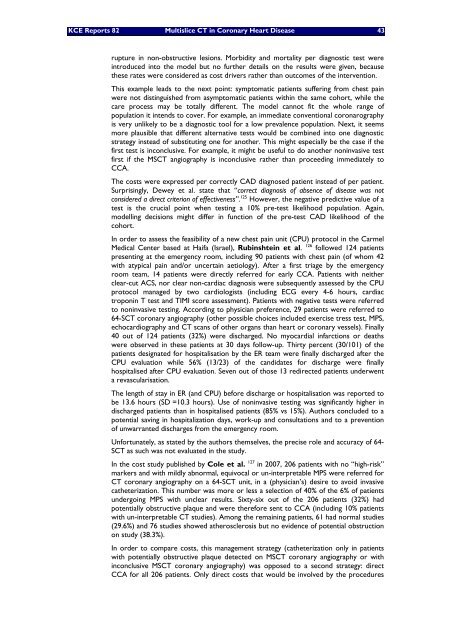Download the full report (116 p.) - KCE
Download the full report (116 p.) - KCE
Download the full report (116 p.) - KCE
You also want an ePaper? Increase the reach of your titles
YUMPU automatically turns print PDFs into web optimized ePapers that Google loves.
<strong>KCE</strong> Reports 82 Multislice CT in Coronary Heart Disease 43<br />
rupture in non-obstructive lesions. Morbidity and mortality per diagnostic test were<br />
introduced into <strong>the</strong> model but no fur<strong>the</strong>r details on <strong>the</strong> results were given, because<br />
<strong>the</strong>se rates were considered as cost drivers ra<strong>the</strong>r than outcomes of <strong>the</strong> intervention.<br />
This example leads to <strong>the</strong> next point: symptomatic patients suffering from chest pain<br />
were not distinguished from asymptomatic patients within <strong>the</strong> same cohort, while <strong>the</strong><br />
care process may be totally different. The model cannot fit <strong>the</strong> whole range of<br />
population it intends to cover. For example, an immediate conventional coronarography<br />
is very unlikely to be a diagnostic tool for a low prevalence population. Next, it seems<br />
more plausible that different alternative tests would be combined into one diagnostic<br />
strategy instead of substituting one for ano<strong>the</strong>r. This might especially be <strong>the</strong> case if <strong>the</strong><br />
first test is inconclusive. For example, it might be useful to do ano<strong>the</strong>r noninvasive test<br />
first if <strong>the</strong> MSCT angiography is inconclusive ra<strong>the</strong>r than proceeding immediately to<br />
CCA.<br />
The costs were expressed per correctly CAD diagnosed patient instead of per patient.<br />
Surprisingly, Dewey et al. state that “correct diagnosis of absence of disease was not<br />
considered a direct criterion of effectiveness”. 125 However, <strong>the</strong> negative predictive value of a<br />
test is <strong>the</strong> crucial point when testing a 10% pre-test likelihood population. Again,<br />
modelling decisions might differ in function of <strong>the</strong> pre-test CAD likelihood of <strong>the</strong><br />
cohort.<br />
In order to assess <strong>the</strong> feasibility of a new chest pain unit (CPU) protocol in <strong>the</strong> Carmel<br />
Medical Center based at Haifa (Israel), Rubinshtein et al. 126 followed 124 patients<br />
presenting at <strong>the</strong> emergency room, including 90 patients with chest pain (of whom 42<br />
with atypical pain and/or uncertain aetiology). After a first triage by <strong>the</strong> emergency<br />
room team, 14 patients were directly referred for early CCA. Patients with nei<strong>the</strong>r<br />
clear-cut ACS, nor clear non-cardiac diagnosis were subsequently assessed by <strong>the</strong> CPU<br />
protocol managed by two cardiologists (including ECG every 4-6 hours, cardiac<br />
troponin T test and TIMI score assessment). Patients with negative tests were referred<br />
to noninvasive testing. According to physician preference, 29 patients were referred to<br />
64-SCT coronary angiography (o<strong>the</strong>r possible choices included exercise tress test, MPS,<br />
echocardiography and CT scans of o<strong>the</strong>r organs than heart or coronary vessels). Finally<br />
40 out of 124 patients (32%) were discharged. No myocardial infarctions or deaths<br />
were observed in <strong>the</strong>se patients at 30 days follow-up. Thirty percent (30/101) of <strong>the</strong><br />
patients designated for hospitalisation by <strong>the</strong> ER team were finally discharged after <strong>the</strong><br />
CPU evaluation while 56% (13/23) of <strong>the</strong> candidates for discharge were finally<br />
hospitalised after CPU evaluation. Seven out of those 13 redirected patients underwent<br />
a revascularisation.<br />
The length of stay in ER (and CPU) before discharge or hospitalisation was <strong>report</strong>ed to<br />
be 13.6 hours (SD =10.3 hours). Use of noninvasive testing was significantly higher in<br />
discharged patients than in hospitalised patients (85% vs 15%). Authors concluded to a<br />
potential saving in hospitalization days, work-up and consultations and to a prevention<br />
of unwarranted discharges from <strong>the</strong> emergency room.<br />
Unfortunately, as stated by <strong>the</strong> authors <strong>the</strong>mselves, <strong>the</strong> precise role and accuracy of 64-<br />
SCT as such was not evaluated in <strong>the</strong> study.<br />
In <strong>the</strong> cost study published by Cole et al. 127 in 2007, 206 patients with no “high-risk”<br />
markers and with mildly abnormal, equivocal or un-interpretable MPS were referred for<br />
CT coronary angiography on a 64-SCT unit, in a (physician’s) desire to avoid invasive<br />
ca<strong>the</strong>terization. This number was more or less a selection of 40% of <strong>the</strong> 6% of patients<br />
undergoing MPS with unclear results. Sixty-six out of <strong>the</strong> 206 patients (32%) had<br />
potentially obstructive plaque and were <strong>the</strong>refore sent to CCA (including 10% patients<br />
with un-interpretable CT studies). Among <strong>the</strong> remaining patients, 61 had normal studies<br />
(29.6%) and 76 studies showed a<strong>the</strong>rosclerosis but no evidence of potential obstruction<br />
on study (38.3%).<br />
In order to compare costs, this management strategy (ca<strong>the</strong>terization only in patients<br />
with potentially obstructive plaque detected on MSCT coronary angiography or with<br />
inconclusive MSCT coronary angiography) was opposed to a second strategy: direct<br />
CCA for all 206 patients. Only direct costs that would be involved by <strong>the</strong> procedures

















